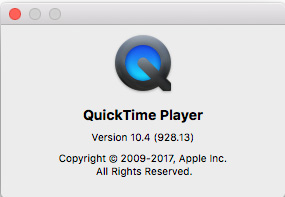

- #QUICKTIME PLAYER 7.6.6 FOR MAC LICENSE KEY#
- #QUICKTIME PLAYER 7.6.6 FOR MAC MAC OS X#
- #QUICKTIME PLAYER 7.6.6 FOR MAC MAC OS#
- #QUICKTIME PLAYER 7.6.6 FOR MAC MOVIE#
- #QUICKTIME PLAYER 7.6.6 FOR MAC INSTALL#
The ability to contain abstract data references for the media data, and the separation of the media data from the media offsets and the track edit lists means that QuickTime is particularly suited for editing, as it is capable of importing and editing in place (without data copying). Each track either contains a digitally-encoded media stream (using a specific format) or a data reference to the media stream located in another file. The native file format for QuickTime video, QuickTime File Format, specifies a multimedia container file that contains one or more tracks, each of which stores a particular type of data: audio, video, effects, or text (e.g. It is used to view picture files from the still image formats that QuickTime supports.
#QUICKTIME PLAYER 7.6.6 FOR MAC MAC OS#
PictureViewer is a component of QuickTime for Microsoft Windows and the Mac OS 8 and Mac OS 9 operating systems.

The framework supports the following file types and codecs natively: Audio A "component" plug-in architecture for supporting additional 3rd-party codecs (such as DivX).Īs of early 2008, the framework hides many older codecs listed below from the user although the option to "Show legacy encoders" exists in QuickTime Preferences to use them.In Mac OS X, QuickTime sends video playback to the Quartz Extreme (OpenGL) Compositor. Decoding video and audio, then sending the decoded stream to the graphics or audio subsystem for playback.Encoding and transcoding video and audio from one format to another.The QuickTime framework provides the following:
#QUICKTIME PLAYER 7.6.6 FOR MAC INSTALL#
Otherwise, users will have to specify during installation that they want to install QuickTime 7 on their computers.
#QUICKTIME PLAYER 7.6.6 FOR MAC MAC OS X#
Users do not have an option to upgrade to a pro version of QuickTime X, but those who have already purchased QuickTime 7 Pro and are upgrading to Snow Leopard from a previous version of Mac OS X will have QuickTime 7 stored in the Utilities or user defined folder. QuickTime Player X lacks cut, copy and paste and will only export to four formats, but its limited export feature is free. Mac OS X Snow Leopard includes QuickTime X. Save as QuickTime movie – This option will save the embedded video in a *.mov file format no matter what the original container is/was.Save as source – This option will save the embedded video in its original format.It should be noted that two options exist for saving movies from a web browser: This is often, but not always, either hidden or intentionally blocked in the standard mode. Saving existing QuickTime movies from the web directly to a hard disk drive.QuickTime 7 includes presets for exporting video to a video-capable iPod, Apple TV, and the iPhone. Saving and exporting ( encoding) to any of the codecs supported by QuickTime.Editing clips through the cut, copy and paste functions, merging separate audio and video tracks, and freely placing the video tracks on a virtual canvas with the options of cropping and rotation.Also, the Pro key does not entail any additional downloads.įeatures enabled by the Pro license include, but are not limited to: Pro keys are specific to the major version of QuickTime for which they are purchased and unlock additional features of the QuickTime Player application on Mac OS X or Windows. Final Cut Studio, Logic Studio) include a QuickTime Pro license.
#QUICKTIME PLAYER 7.6.6 FOR MAC LICENSE KEY#
QuickTime Player 7 is limited to only basic playback operations unless a QuickTime Pro license key is purchased from Apple.
#QUICKTIME PLAYER 7.6.6 FOR MAC MOVIE#
In addition, Mac OS X has a simple AppleScript which can be used to play a movie in full-screen mode., but since version 7.2 full-screen viewing is now supported in the non-pro version. For example, iTunes can export audio in WAV, AIFF, MP3, AAC, and Apple Lossless. There are some other free player applications that rely on the QuickTime framework, providing features not available in the basic QuickTime Player. It is available free of charge for both Mac OS X and Windows operating systems. Software development kits (SDKs) for QuickTime are available to the public with an Apple Developer Connection (ADC) subscription. QuickTime for Microsoft Windows is downloadable, either as a standalone installation or bundled with iTunes or optionally with Safari. QuickTime is integrated with Mac OS X, but was once an optional component during installation for earlier versions of Mac OS. 6 Creating software that uses QuickTime.5.8 QuickTime X (QuickTime Player v10.x).


 0 kommentar(er)
0 kommentar(er)
